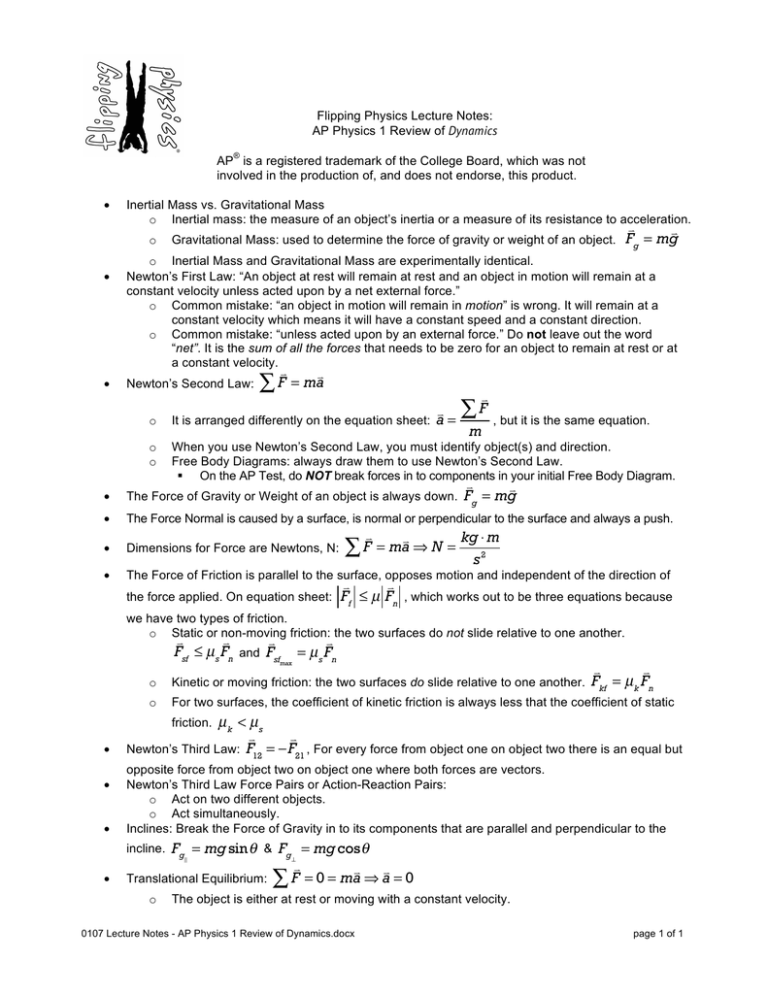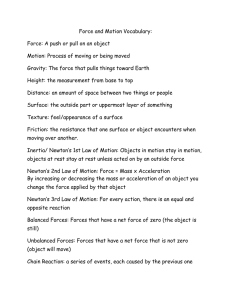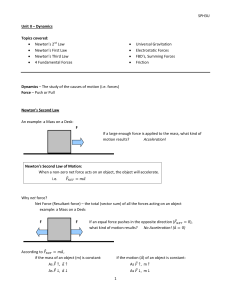Lecture Notes - Flipping Physics
advertisement

Flipping Physics Lecture Notes: AP Physics 1 Review of Dynamics ® AP is a registered trademark of the College Board, which was not involved in the production of, and does not endorse, this product. • Inertial Mass vs. Gravitational Mass o Inertial mass: the measure of an object’s inertia or a measure of its resistance to acceleration. o • • Gravitational Mass: used to determine the force of gravity or weight of an object. ! ! Fg = mg o Inertial Mass and Gravitational Mass are experimentally identical. Newton’s First Law: “An object at rest will remain at rest and an object in motion will remain at a constant velocity unless acted upon by a net external force.” o Common mistake: “an object in motion will remain in motion” is wrong. It will remain at a constant velocity which means it will have a constant speed and a constant direction. o Common mistake: “unless acted upon by an external force.” Do not leave out the word “net”. It is the sum of all the forces that needs to be zero for an object to remain at rest or at a constant velocity. Newton’s Second Law: o o o ! ! ∑ F = ma ! It is arranged differently on the equation sheet: a = ! F ∑ m , but it is the same equation. When you use Newton’s Second Law, you must identify object(s) and direction. Free Body Diagrams: always draw them to use Newton’s Second Law. § On the AP Test, do NOT break forces in to components in your initial Free Body Diagram. ! ! Fg = mg • The Force of Gravity or Weight of an object is always down. • The Force Normal is caused by a surface, is normal or perpendicular to the surface and always a push. • Dimensions for Force are Newtons, N: • The Force of Friction is parallel to the surface, opposes motion and independent of the direction of the force applied. On equation sheet: ! ! ∑ F = ma ⇒ N = kg ⋅ m s2 ! ! Ff ≤ µ Fn , which works out to be three equations because we have two types of friction. o Static or non-moving friction: the two surfaces do not slide relative to one another. ! ! ! Fsf ≤ µ s Fn and Fsf ! = µ s Fn max ! ! Fkf = µ k Fn o Kinetic or moving friction: the two surfaces do slide relative to one another. o For two surfaces, the coefficient of kinetic friction is always less that the coefficient of static µk < µs ! ! Newton’s Third Law: F12 = − F21 , For every force from object one on object two there is an equal but friction. • • • opposite force from object two on object one where both forces are vectors. Newton’s Third Law Force Pairs or Action-Reaction Pairs: o Act on two different objects. o Act simultaneously. Inclines: Break the Force of Gravity in to its components that are parallel and perpendicular to the incline. Fg = mg sin θ & Fg = mg cos θ ! • Translational Equilibrium: o ⊥ ! ! ! ∑ F = 0 = ma ⇒ a = 0 The object is either at rest or moving with a constant velocity. 0107 Lecture Notes - AP Physics 1 Review of Dynamics.docx page 1 of 1


